Notes from our CoVid-19 Future in Australia
What does looking at South Korea tell us?
Now that the initial numbers of COVID-19 cases have been suppressed in Australia, and are looking promising, it is time to start thinking more deeply about what the next 12 months looks like. In this first of a series of posts, I want to look at what South Korea has done to think about the Australian future. In order to do that I have trawled back through all of the press releases from the Korean CDC website since February 17 [ The Korean CDC is an excellent source of information on what has been happening. See: https://www.cdc.go.kr/board/board.es?mid=a30402000000&bid=0030].
The data from April 7 shows very clearly the situation to April 3:
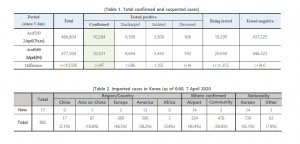
The key points are that:
- They have had just over 10,000 cases.
- Only 802 of those cases are imported cases as of April 7.
- They have tested 446,323 people by April 3 or 8,705 people out of every million people [This is about the same rate as Victoria as of April 7th but lower than NSW at 15,530 per million people].
The shape and nature of the Korean outbreak has been unique in the world.
The pattern looks like this [From:
https://www.worldometers.info/coronavirus/country/south-korea/]:
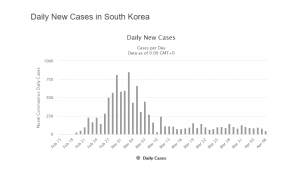
They initially had a rapid rise in cases and have brought that back under control with new cases since March 12 averaging approximately one hundred per day with some ups and downs
As can be seen in the following table, the initial outbreak levels were due to some very highly clustered outbreaks.
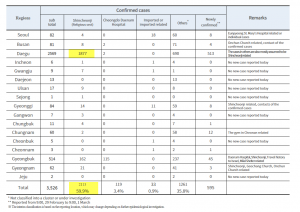
At February 29/March 1, which is in the middle of the peak in the chart above, almost 60% of the total of 3,526 cases were related to the Schincheonji religious sect.
This meant that the initial response could be highly targeted in terms of testing and contact tracing, which allowed South Korea to throw a lot of resources into a concentrated fight.
The rest of my summary of the timetable is detailed below as an appendix as it is quite long.
The key points are:
The initial outbreak was highly clustered around the Schincheonji religious sect, and I think that this should be treated as almost a sperate outbreak. The clustering makes containment and contact tracing less difficult than a wider spread problem.
Due to the rapid and extensive action of the Korean authorities, the initial high numbers were quickly brought down.
Since that time, the actions of the government have been quite similar to the Australian context with a few differences. The key steps were:
- Ongoing high levels of testing and contact tracing/epidemiological investigation.
- Increasing instructions and requirements for citizens to reduce contact.
- Steady tightening of the controls at the border, which changed as the source of overseas infection changed.
The differences were:
- The requirement from March 19 for all international travellers:
The Special Entry Procedure requires the traveller to be checked for fever, provide a confirmed contact information at port entry, and report their symptoms daily for the next 14 days via self-health check mobile app
- On March 27:
. Persons subject to self-quarantine will be issued a self-quarantine notice at the airport. Failure to comply is punishable by imprisonment up to 1 year or a fine up to 10 million won. They are also required to install the self-quarantine mobile app (made by the Ministry of the Interior and Safety) on their phone, so that their local government can monitor their self-quarantine [It is unclear whether the app requirement from earlier had the capacity to track people or just had people reporting in].
- From April 1 more extensive border controls:
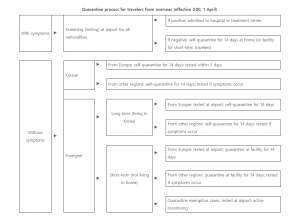
Persons traveling in from overseas who fail to comply with self-quarantine regulations are subject to imprisonment up to 1 year or fine up to 10 million won (effective April 5) for violation of Infectious Disease Control and Prevention Act (Paragraph 1 of Article 49 and Article 79-3). Persons of foreign nationality who fail to comply may be subject to measures including deportation and entry ban in accordance with Immigration Act (Articles 11 and 46).
- April 5 – extra stringency over false documents at the border:
At the point of entry (quarantine investigation process), there have been cases of stating false content or not complying with the quarantine rules. KCDC says that they could be punished in this case and urged to cooperate with quarantine rules and COVID-19 measure.
– If you submit false documents at the point of entry, you may be imprisoned for up to 1 year or fined up to 10 million won for violating the Quarantine Act under Article 12 & Article 39(1). The reporting is important for you, family, and the community to get early-testing.
Besides the possible punishments and the tracking app, the overall approach does not look a great deal different than the Australian approach. South Korea now has an extended period of relatively low case numbers that have reduced further in the last two days.
I think it is reasonable to look at their example and think that something similar could be applied in Australia to keep case numbers relatively low. Going through all of the data from South Korea gave me a different view than the general media reports I have been reading. In particular, the similarities with Australia were striking. The open question is how cultural differences have made a difference and what might be the differences between people’s attitudes from different countries as restrictions are relaxed a bit.
My bias is that I think Australians will be less tolerant of some restrictions than countries such as Japan, South Korea and Singapore. My other bias is that I think that the authorities have been a little shocked at the level of flouting of regulations. That will increase the level of regulation in the future given lack of confidence in following recommendations
The other key to my thinking is that as we only currently have a little over 6,000 confirmed cases (there are bound to be undiagnosed cases) we will still have a very susceptible population. Even if the actual cases rise to 50,000 over the next few weeks, we would have 99.8% of the population without immunity. That means a restart of an epidemic in the country is possible at any time if community transmission starts to rise.
Given those statements I think that in a few months it looks like this:
- An ongoing low level of transmission in the community with variations.
- Large scale testing so we know what is going on and mobile contact tracing teams so that we can jump on to any clusters of infection that form.
- Ongoing social distancing measures that could consist of things like:
- Ongoing partial school closures, especially if the current distance learning efforts are seen to work.
- Restrictions on how many people can gather publicly but at higher numbers than we currently have.
- Ongoing restrictions for café’s, bars and restaurants, cinemas, gyms, etc to increase the space per patron but allow use (I think many people will still be wary and numbers will be down anyway).
- Continued banning of large-scale events such as large conferences, crowds at sporting events, big cultural festivals and events.
- Increased penalties for breaking restrictions which will be politically marketed as allowing restrictions to be relaxed – one of the the reasons you have a brake in your car is to allow you to you drive faster.
- Ongoing isolation of people over 70 (the mortality data coming out of South Korea for older people should ensure that happens out of choice given it is happening in a modern, non-overwhelmed medical system.
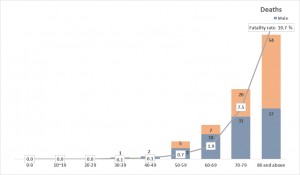
- Periodic restrictions in regions, cities, or states if community transmission flares up more than a certain amount.
- Relaxation of restrictions at State borders unless a particular state runs out of control.
- Continued and significant restrictions at the national borders as many countries in the low phase of this outbreak have had more of their cases coming from overseas than internally. These will probably look something like the current South Korean system but I am expecting forced facility isolation to be part of the set up given how many people have flouted the self-isolation rules (see: https://www.abc.net.au/news/2020-04-04/coronavirus-australia-live-blog-updates-covid-19-april-4/12120782)
Current government policy is not designed to eliminate the virus from the Australian population. It is designed to give us some breathing space so the testing capacity, contract tracing capacity and health system are all ready for a time when restrictions are slowly lifted. As someone said to me this morning this is a marathon, not a sprint. It is also a marathon over a course that we have not been allowed to practice on. We must be prepared for changes in the terrain.
Appendix: Detailed Timeline
On February 21 the CDC stated:
As this week’s surge in the number of confirmed cases, KCDC alarmed against the possibility of community transmission. KCDC also advised that anyone who have attended a service at Shincheonji Church or visited Cheongdo Daenam hospital in February should stay home and avoid unnecessary outdoor activities. If they have fever or respiratory symptoms, they should first get a consultation with KCDC Call Center(1339) or a triage health center nearby before going to health care facilities.
On the 22nd:
A rapid response team, sent to Daegu, is conducting epidemiological investigation and environmental disinfection on the Shincheonji cluster. The Shincheonji members have been monitored for the symptoms, and they get tested upon the onset of symptoms. Also, their travel history is being investigated.
It is recommended for residents in Daegu to minimize gathering events and outdoor activities.
On the 24th they started to go wider
The Korean government has raised the alert level from Orange(Level 3) to Red (Level 4) in order to prepare for a possible nation-wide transmission.
From then on it was a combination of tightening of controls both for the domestic population and at the borders.
On March 1:
KCDC pointed out that from this weekend to the early March would be a great turning point of COVID-19 outbreak in Korea and emphasized the importance of personal hygiene practice and social distancing. It is critical that the public follows the guidance for COVID-19 prevention, such as washing hands with soap and running water and covering mouth and nose with elbow when coughing.
Furthermore, anyone having fever or respiratory symptoms should avoid having in contact with others, visiting a crowded place, or attending religious gatherings. High-risk group, such as the elderly over 65 year old, people with underlying chronic conditions, and pregnant women, is advised not to visit a crowded place. When they have to visit a health facility, they should wear a facemask
March 11:
Since the contact with the confirmed cases in a closed place increases the possibility of transmission, it is recommended to work at home or adjust desk locations so as to keep a certain distance among people in the office. More detailed guidelines for local governments and high-risk working environment will be distributed soon.
On March 12 they started to further tighten border controls to reflect growing case numbers in Europe:
To prevent further imported cases, special immigration procedures will be expanded to the European region in response to the recent rapid increase of local transmission. The procedures will begin to take effect at 0:00 of March 15 for all Korean and international travelers arriving after having visited or lived in France, Germany, Spain, the U.K. or the Netherlands.
On March 16 they tightened things further domestically:
In light of the recent emergence of new confirmed cases by local transmission at close-contact indoor gatherings, the KCDC again strongly recommended that all such gatherings be canceled or refrained as best as possible.
The KCDC recommended that businesses and workplaces improve their on-site environment to enable distancing measures, periodically ventilate and disinfect their facilities, and adopt remote working environments for employees such as work-at-home and online collaboration.
○ The KCDC stressed the importance of continued adherence to social distancing measures to prevent transmission to high-risk groups. Expressing concern that the virus may be contracted by healthy adults and children via workplaces and schools and transmitted to the vulnerable groups such as the elderly and people with underlying illnesses via healthcare facilities, social welfare centers, religious gatherings, or other community spaces and events. the KCDC strongly advised that the elderly stay at home as much as possible and refrain from visiting places visited by a large number of people.
It needs to be remembered that these measures are being put in place even though the new case numbers have fallen significantly by this date. From March 14th-16th they had only had 253 cases in three days compared to a peak of 851 cases in one day.
On March 17 they tightened border controls further:
In light of the recent rise in the number of confirmed cases from airport quarantine, the KCDC announced that the Special Entry Procedure will be extended to all travelers arriving at port beginning at 0:00 of March 19. The Special Entry Procedure requires the traveler to be checked for fever, provide a confirmed contact information at port entry, and report their symptoms daily for the next 14 days via self-health check mobile app. Travel history of all travelers entering Korea will be provided to healthcare providers via the International Traveler Information System for reference.
○ Travelers who have visited Europe, the U.S., or Asia in the past 14 days are advised to minimize movement, adhere to social distancing personal hygiene measures, since infected persons with mild symptoms in initial stages of the disease may unknowingly transmit the virus to other people.
On March 19th things tightened further:
The KCDC strongly recommended canceling or delaying of all international travel on non-urgent matters. Persons who are unable to avoid traveling out of the country for a critical reason are advised to refrain from visiting any closed facilities or healthcare facilities, and voluntarily disclose any symptoms and their international travel history upon returning to Korea and follow appropriate guidelines and instructions.
○ In light of the continued emergence of outbreaks in health facilities and church clusters, the KCDC stressed the importance of strengthening prevention management for such community facilities. The KCDC urged people to refrain from attending crowded places or religious gatherings and recommended that workplaces actively encourage and enable employees to work remotely from home.
On March 22 further tightening of borders was announced:
○ In light of the recent surge in the number of COVID-19 cases in the European region including Italy, Spain, France, the U.K., as well as the rise in the number of imported cases found both at airport quarantine and in local communities (total imported cases = 86; imported cases from Europe = 50), stronger entry procedures will be implemented from March 22 for persons traveling from Europe. All persons arriving from Europe will be required to answer a questionnaire on their health condition, get checked for fever, and get tested after being escorted to an appropriate facility — quarantine facility for persons with symptoms and designated temporary living facilities for those without symptoms. Those whose test comes out positive will either be moved a hospital or a Life Treatment Center based on the severity level assessed for each case. In principle, Korean citizens or resident aliens who test negative go into self-quarantine at their place of residence. Those without a place of residence in Korea will be quarantined at a facility. Foreigners who are temporarily staying in Korea for a short time will subject to active monitoring during their stay in Korea. Travel histories of all travelers entering Korea will be provided to healthcare providers via the International Traveler Information System for reference. The names of all entrants will be provided to local public health centers for a more active monitoring of potential imported cases for the first 14 days upon their arrival.
This was in light of increasing cases arriving from Europe as shown below.
In light of the continued emergence of outbreaks in religious group, and other facilities, the KCDC stresses the public to strictly comply with social distancing from March 22 to April 5 for 15days before opening the school. The KCDC urged the public to stay at home excluding necessary reason like purchasing daily necessity, visiting at health facilities, and commuting.
○ Korean government will restrict the operation of some facilities, such as religious facilities, indoor sports, and entertainment facilities which are at high risk of infection. Inevitably, when operating, it is necessary to strictly follow the guideline set by the KCDC, such as disinfection and ventilation, social distancing, and wearing a mask.
On March 25 travel tightening extended to the USA and a severe punishment for not complying with self-quarantine as an inbound traveller and a requirement to install an app on your phone for monitoring:
In light of the recent surge in COVID-19 cases in the United States and the rise in the number of imported cases from the US, starting 0:00 of March 27, a stronger screening process will be applied for inbound travelers from the United States. All symptomatic persons entering from the US, regardless of nationality, will be required to wait for testing in a facility within the airport. Persons who test positive will be transferred to a hospital or “Life Treatment Center”. Persons who test negative will enter self-quarantine at home for 14 days. Korean nationals and foreigners with a domestic residence who are asymptomatic at the time of entry will enter self-quarantine in their home for 14 days and get tested if symptoms begin to occur. Foreigners who are on a short-term visit without domestic residence and thus are unable to self-quarantine will be tested in at a temporary facility. If they test negative, they will be allowed entry under enhanced active monitoring.
○ The Central Disaster and Safety Countermeasure Headquarters will strengthen the management of inbound travelers under self-quarantine. Persons subject to self-quarantine will be issued a self-quarantine notice at the airport. Failure to comply is punishable by imprisonment up to 1 year or a fine up to 10 million won. They are also required to install the self-quarantine mobile app (made by the Ministry of the Interior and Safety) on their phone, so that their local government can monitor their self-quarantine.
March 28:
– Persons entering from Europe or the US should return home straight after arriving at the airport, refrain from using public transportation, travel in their own vehicle, and wear a face-mask during movement. Beginning March 28, airport limousine bus or KTX train will be provided for inbound travelers who cannot access to their own vehicle.
And:
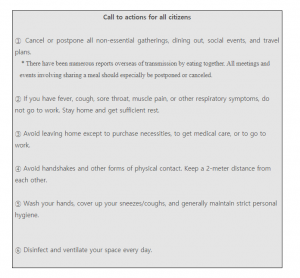
March 30 : Control measures were tightened for border control

○ Persons traveling in from overseas who fail to comply with self-quarantine regulations are subject to imprisonment up to 1 year or fine up to 10 million won (effective April 5) for violation of Infectious Disease Control and Prevention Act (Paragraph 1 of Article 49 and Article 79-3). Persons of foreign nationality who fail to comply may be subject to measures including deportation and entry ban in accordance with Immigration Act (Articles 11 and 46).
April 4:
○ KCDC also asked the public to keep practicing the enhanced social distancing, which had been extended to April 19. People should stay home as much as possible during the weekend, avoid any activities that make it easy to come in close contact with others, and maintain good personal hygiene including coughing etiquette and washing hands. Furthermore, KCDC recommended the public to disinfect the environment using a right disinfectant approved by the Ministry of Environment and following a proper guideline. As a preventative measure, the public place and house could be disinfected on a regular basis. It is advised to wipe down the items that people can often use or touch, such as a door knob, elevator button, desk, keyboard, light switch, and armrest while ventilating the space.
April 5:
At the point of entry (quarantine investigation process), there have been cases of stating false content or not complying with the quarantine rules. KCDC says that they could be punished in this case, and urged to cooperate with quarantine rules and COVID-19 measure.
– If you submit false documents at the point of entry, you may be imprisoned for up to 1 year or fined up to 10 million won for violating the Quarantine Act under Article 12 & Article 39(1). The reporting is important for you, family, and the community to get early-testing.



